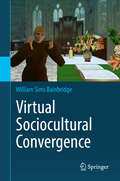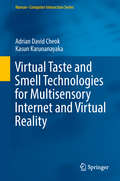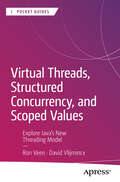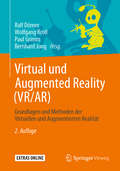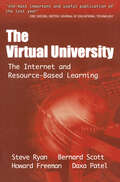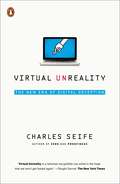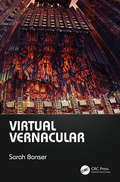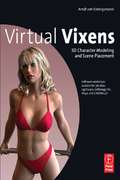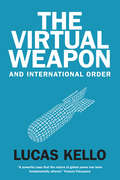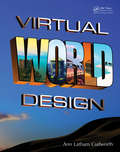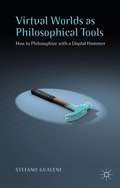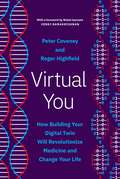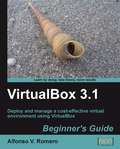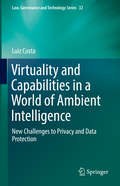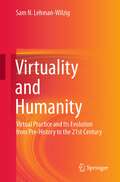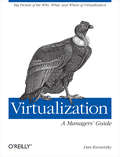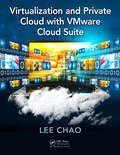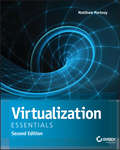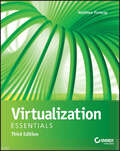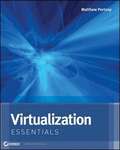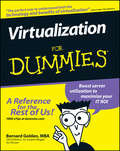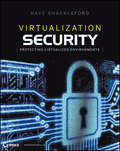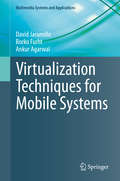- Table View
- List View
Virtual Sociocultural Convergence
by William Sims BainbridgeThis book explores the remarkable sociocultural convergencein multiplayer online games and other virtual worlds, through the unificationof computer science, social science, and the humanities. The emergence of online media provides notonly new methods for collecting social science data, but also contexts fordeveloping theory and conducting education in the arts as well astechnology. Notably, role-playing gamesand virtual worlds naturally demonstrate many classical concepts about human behaviour,in ways that encourage innovative thinking. The inspiration derives from the internationally shared values developedin a fifteen-year series of conferences on science and technology convergence. The primary methodology is focused on sending avatars, representingclassical social theorists or schools of thought, into online gameworlds thatharmonize with, or challenge, their fundamental ideas, including technologicaldeterminism, urban sociology, group formation, freedom versus control, classstratification, linguistic variation, functional equivalence across cultures, behaviouralpsychology, civilization collapse, and ethnic pluralism. Researchers and students in the social and behaviouralsciences will benefit from the many diverse examples of how both qualitativeand quantitative science of culture and society can be performed in onlinecommunities of many kinds, even as artists and gamers learn styles and skillsthey may apply in their own work and play.
Virtual Taste and Smell Technologies for Multisensory Internet and Virtual Reality
by Adrian David Cheok Kasun KarunanayakaCurrently, Internet and virtual reality communication is essentially audio-visual. The next important breakthrough of the Internet will be the communication and sharing of smell and taste experiences digitally. Audio-visual stimuli are frequency based, and they can be easily digitized and actuated. On the other hand, taste and smell stimuli are based on chemical molecules, therefore, they are not easy to digitize or actuate. To solve this problem, we are required to discover new digital actuation technologies for taste and smell. The authors of this book have experimented on developing digital actuation devices for several years. This book will provide a complete overview of the importance of digitizing taste and smell, prior works, proposed technologies by the authors, other state of the art research, advantages and limitations of the proposed methods, and future applications. We expect digital taste and smell technologies will revolutionize the field of multisensory augmented reality and open up new interaction possibilities in different disciplines such as Human Computer Interaction, Communication, and Augmented and Virtual Reality.
Virtual Threads, Structured Concurrency, and Scoped Values: Explore Java’s New Threading Model (Apress Pocket Guides)
by Ron Veen David VlijmincxDiscover the exciting new APIs introduced by Java’s Project Loom. This quick guide covers all the essential concepts the Java developer needs in order to understand virtual threads, structured concurrency, and scoped values. Authors Ron Veen and David Vlijmincx clearly explain the superiority of virtual threads, introduced in Java 21, over the traditional Java threads of the past 25 years. Then they dive into how structured concurrency streamlines interactions by treating related threads as a unified unit of work, akin to the impact of structured programming on regular programming. From there, the authors explore the third Project Loom API and scoped values, clarifying their advantages over regular ThreadLocals and providing efficient usage insights. The book concludes with an exploration of common scheduling strategies. By the end of this book, you will have a solid understanding of the concepts behind Project Loom and will be able to immediately apply this knowledge to your own code. You Will Discover what virtual threads are, why they were created, and how to use them in your code Gain insight into how concurrency improves the observability of code Write your own StructuredTaskScopes tailored to your needs Understand why you should replace ThreadLocals with Scoped Values Know the different strategies for multithreaded computer programs Who This Book is For Java developers of any level. This knowledge is so fundamental to staying relevant in the Java job market that every developer needs to understand it for their career development.
Virtual und Augmented Reality: Grundlagen und Methoden der Virtuellen und Augmentierten Realität (Examen. Press Ser.)
by Ralf Dörner Wolfgang Broll Paul Grimm Bernhard JungLernen Sie mit diesem Buch die Grundlagen der Virtuellen und Augmentierten Realität kennen Dieses Buch über die Virtuelle und Augmentierte Realität ist sowohl für Praktiker und Interessierte im Selbststudium als auch für Studierende geeignet. Letztere können es hervorragend als Begleitlektüre für entsprechende Lehrveranstaltungen, zum Beispiel in der Informatik nutzen. Die zweite Auflage wurde umfassend erneuert und erweitert. Mit ihrer Hilfe kann der Leser sein Verständnis für das Themengebiet rund um die VR und AR vertiefen. Thematisch schneidet das Buch viele Bereiche der Virtuellen und Augmentierten Realität an, darunter beispielsweise Wahrnehmungsaspekte der AR, Interaktionen in einer virtuellen Welt oder die mathematischen Basics für VR und AR. (105)
Virtual und Augmented Reality: Grundlagen und Methoden der Virtuellen und Augmentierten Realität (eXamen.press)
by Ralf Dörner, Wolfgang Broll, Paul Grimm and Bernhard JungDas Lehrbuch vermittelt die theoretischen und praktischen Grundlagen, die benötigt werden, um Virtual- und Augmented-Reality-Systeme (VR/AR) eigenständig zu realisieren oder zu erweitern. Es dient Studierenden als anschauliche Begleitlektüre zu Lehrveranstaltungen, die VR/AR thematisieren, u. a. in den Fächern Informatik, Medien oder Natur- und Ingenieurwissenschaften. Durch seinen modularen Aufbau eignet sich der Band auch für das Selbststudium und kann darüber hinaus als Nachschlagewerk verwendet werden.
The Virtual University: The Internet and Resource-based Learning (Open and Flexible Learning Series)
by Howard Freeman Bernard Scott Steve Ryan Daxa PatelA discussion of the increased accessibility to the Internet and how this has lead to a variety of resources being used for learning. Case studies and examples show the benefits of using the Internet as part of resource-based learning.
Virtual Unreality
by Charles SeifeThe bestselling author of Proofiness and Zero explains how to separate fact from fantasy in the digital world Digital information is a powerful tool that spreads unbelievably rapidly, infects all corners of society, and is all but impossible to control--even when that information is actually a lie. In Virtual Unreality, Charles Seife uses the skepticism, wit, and sharp facility for analysis that captivated readers in Proofiness and Zero to take us deep into the Internet information jungle and cut a path through the trickery, fakery, and cyber skullduggery that the online world enables. Taking on everything from breaking news coverage and online dating to program trading and that eccentric and unreliable source that is Wikipedia, Seife arms his readers with actual tools--or weapons--for discerning truth from fiction online.
Virtual Unreality
by Charles SeifeThe bestselling author of Proofiness and Zero explains how to separate fact from fantasy in the digital world Digital information is a powerful tool that spreads unbelievably rapidly, infects all corners of society, and is all but impossible to control--even when that information is actually a lie. In Virtual Unreality, Charles Seife uses the skepticism, wit, and sharp facility for analysis that captivated readers in Proofiness and Zero to take us deep into the Internet information jungle and cut a path through the trickery, fakery, and cyber skullduggery that the online world enables. Taking on everything from breaking news coverage and online dating to program trading and that eccentric and unreliable source that is Wikipedia, Seife arms his readers with actual tools--or weapons--for discerning truth from fiction online.
Virtual Vernacular
by Sarah BonserLearn to see the patterns and relationships in visual mediums and buildings as you push the boundaries of design. Sarah Bonser’s Virtual Vernacular breaks the barriers between architectural theory and game design. The text explores the way in which architecture can convey history, culture, and emotion to occupants, audience members, and players. Divided into three sections, the text guides the reader on how to tackle creative problem solving and development strategy. Key Features: Architectural theory is hard to navigate, and this approach is an accessible way to start learning it. Learn more specifically how pop culture parodies these design theories. Find ways to solve abstract design problems by using the built environment as a case study. Learn about technical limitations on the built environment that visually impact the look and feel of spaces. Each piece of architectural theory comes with abstracts and applications, which is a more organized and network-style way to teach an otherwise long-winded subject.
Virtual Vixens: 3D Character Modeling and Scene Placement
by Arndt Von KoenigsmarckFeatures software workshops for 3ds Max, Maya, CINEMA 4D, Lightwave, and Softimage XSI.Hot, hotter, hottest. See how today's leading modeling artists create 3D characters that sizzle and get the techniques you'll need to create your own virtual vixens.Steven Stahlberg, Liam Kemp, Marco Patrito, and Sze Jones from Blur Studio are just a few of the 3D artists who share their secrets for making the fantasy females you wish were real. You'll get their personal stories, insights into the profession, and new ways to conceive and construct your own 3D characters.Then, seven hands-on workshops demonstrate the complete work cycle of modeling 3D characters to bring your own fantasies to life-from making the first sketch and preparing the template to modeling and texturing characters and lighting and rendering. You can use the techniques with any of the major software tools including 3ds Max, Lightwave, Softimage XSI, Maya, or Cinema 4D. Since the workshops don't use any previously made objects, you'll get to start from scratch with your imagination as the only limit.Participants:Andrea BertacciniMax Edwin WahyudiSze JonesLiam KempArndt von KoenigsmarckK. C. LeeDaniel Moreno DiazMarco PatritoSteven StahlbergFrancois de Swardt
The Virtual Weapon and International Order
by Lucas KelloAn urgently needed examination of the current cyber revolution that draws on case studies to develop conceptual frameworks for understanding its effects on international order The cyber revolution is the revolution of our time. The rapid expansion of cyberspace brings both promise and peril. It promotes new modes of political interaction, but it also disrupts interstate dealings and empowers non-state actors who may instigate diplomatic and military crises. Despite significant experience with cyber phenomena, the conceptual apparatus to analyze, understand, and address their effects on international order remains primitive. Here, Lucas Kello adapts and applies international relations theory to create new ways of thinking about cyber strategy. Kello draws on a broad range of case studies, including the Estonian crisis, the Olympic Games operation against Iran, and the cyber attack against Sony Pictures. Synthesizing qualitative data from government documents, forensic reports of major incidents and interviews with senior officials from around the globe, this important work establishes new conceptual benchmarks to help security experts adapt strategy and policy to the unprecedented challenges of our times.
Virtual World Design
by Ann CudworthLearn How to Create Immersive Virtual EnvironmentsWritten by an award-winning designer with 20 years of experience designing virtual environments for television and online communities, Virtual World Design explores the intertwining disciplines of 2D graphics, 3D models, lighting, sound, and storytelling. It illustrates how these disciplines come to
Virtual Worlds As Philosophical Tools
by Stefano Gualeni• What does it mean for human beings to 'be' in simulated worlds? • Will experiencing worlds that are not 'actual' change our ways of structuring thought? • Can virtual worlds open up new possibilities to philosophize? Inspired by Martin Heidegger's work,Virtual Worlds as Philosophical Tools seeks to answer these questions from a perspective that combines insights from the field of philosophy of technology with videogame design. Gualeni's exploration casts new light on interactive digital simulations as the context in which a new humanism has already begun to arise. From that perspective, this book articulates an understanding of virtual worlds as philosophical mediators.
Virtual You: How Building Your Digital Twin Will Revolutionize Medicine and Change Your Life
by Peter Coveney Roger HighfieldThe visionary science behind the digital human twins that will enhance our health and our futureVirtual You is a panoramic account of efforts by scientists around the world to build digital twins of human beings, from cells and tissues to organs and whole bodies. These virtual copies will usher in a new era of personalized medicine, one in which your digital twin can help predict your risk of disease, participate in virtual drug trials, shed light on the diet and lifestyle changes that are best for you, and help identify therapies to enhance your well-being and extend your lifespan—but thorny challenges remain.In this deeply illuminating book, Peter Coveney and Roger Highfield reveal what it will take to build a virtual, functional copy of a person in five steps. Along the way, they take you on a fantastic voyage through the complexity of the human body, describing the latest scientific and technological advances—from multiscale modeling to extraordinary new forms of computing—that will make “virtual you” a reality, while also considering the ethical questions inherent to realizing truly predictive medicine.With an incisive foreword by Nobel Prize–winning biologist Venki Ramakrishnan, Virtual You is science at its most astounding, showing how our virtual twins and even whole populations of virtual humans promise to transform our health and our lives in the coming decades.
VirtualBox 3.1: Beginner's Guide
by Alfonso V. RomeroThis beginner's guide consists of comprehensive explanation, appropriate screenshots, tips, tricks, and best practices. It offers step-by-step instructions on building your own virtual environment from scratch, supported by the reasoning behind what you do. If you are a System Administrator who has to set up a virtual machine and want to use an open source tool to do it this book will prove invaluable. No prior knowledge of VirtualBox is required, but you should have experience with general system administration.
Virtuality and Capabilities in a World of Ambient Intelligence
by Luiz CostaThis book is about power and freedoms in our technological world and has two main objectives. The first is to demonstrate that a theoretical exploration of the algorithmic governmentality hypothesis combined with the capability approach is useful for a better understanding of power and freedoms in Ambient Intelligence, a world where information and communication technologies are invisible, interconnected, context aware, personalized, adaptive to humans and act autonomously. The second is to argue that these theories are useful for a better comprehension of privacy and data protection concepts and the evolution of their regulation. Having these objectives in mind, the book outlines a number of theses based on two threads: first, the elimination of the social effects of uncertainty and the risks to freedoms and, second, the vindication of rights. Inspired by and building on the outcomes of different philosophical and legal approaches, this book embodies an effort to better understand the challenges posed by Ambient Intelligence technologies, opening paths for more effective realization of rights and rooting legal norms in the preservation of the potentiality of human capabilities.
Virtuality and Humanity: Virtual Practice and Its Evolution from Pre-History to the 21st Century
by Sam N. Lehman-WilzigThis is a pioneering study of virtuality through human history: ancient-to-modern evolution and recent expansion; expression in many fields (chapters on Religion; Philosophy, Math, Physics; Literature and the Arts; Economics; Nationhood, Government and War; Communication); psychological and social reasons for its universality; inter-relationship with "reality." The book's thesis: virtuality was always an integral part of humanity in many areas of life, generally expanding over the ages. The reasons: 1- brain psychology; 2- virtuality's six functions — escape from boredom to relieving existential dread. Other questions addressed: How will future neuroscience, biotech and "compunications" affect virtuality? Can/should there be limits to human virtualizing?
Virtualization: Big Picture of the Who, What, and Where of Virtualization
by Dan KusnetzkyWhat exactly is virtualization? As this concise book explains, virtualization is a smorgasbord of technologies that offer organizations many advantages, whether you're managing extremely large stores of rapidly changing data, scaling out an application, or harnessing huge amounts of computational power. With this guide, you get an overview of the five main types of virtualization technology, along with information on security, management, and modern use cases.Topics include:Access virtualization—Allows access to any application from any deviceApplication virtualization—Enables applications to run on many different operating systems and hardware platformsProcessing virtualization—Makes one system seem like many, or many seem like oneNetwork virtualization—Presents an artificial view of the network that differs from the physical realityStorage virtualization—Allows many systems to share the same storage devices, enables concealing the location of storage systems, and more
Virtualization and Private Cloud with VMware Cloud Suite
by Lee ChaoTo help readers understand virtualization and cloud computing, this book is designed to cover the theories and concepts enough to understand the cutting-edge technology. Meanwhile, in this book, the reader can gain hands-on skills on VMware Cloud Suite to create a private cloud. With the academic support from VMware, readers can use the VMware supported software to create various virtualized IT infrastructures sophisticated enough for various sized enterprises. Then, the virtualized IT infrastructure can be made available to an enterprise through the private cloud services.
Virtualization Essentials
by Matthew PortnoyLearn virtualization skills by building your own virtual machine Virtualization Essentials, Second Edition provides new and aspiring IT professionals with immersive training in working with virtualization environments. Clear, straightforward discussion simplifies complex concepts, and the hands-on tutorial approach helps you quickly get up to speed on the fundamentals. You'll begin by learning what virtualization is and how it works within the computing environment, then you'll dive right into building your own virtual machine. You'll learn how to set up the CPU, memory, storage, networking, and more as you master the skills that put you in-demand on the job market. Each chapter focuses on a specific goal, and concludes with review questions that test your understanding as well as suggested exercises that help you reinforce what you've learned. As more and more companies are leveraging virtualization, it's imperative that IT professionals have the skills and knowledge to interface with virtualization-centric infrastructures. This book takes a learning-by-doing approach to give you hands-on training and a core understanding of virtualization. Understand how virtualization works Create a virtual machine by scratch and migration Configure and manage basic components and supporting devices Develop the necessary skill set to work in today's virtual world Virtualization was initially used to build test labs, but its use has expanded to become best practice for a tremendous variety of IT solutions including high availability, business continuity, dynamic IT, and more. Cloud computing and DevOps rely on virtualization technologies, and the exponential spread of these and similar applications make virtualization proficiency a major value-add for any IT professional. Virtualization Essentials, Second Edition provides accessible, user-friendly, informative virtualization training for the forward-looking pro.
Virtualization Essentials
by Matthew PortnoyLearn the fundamental concepts and skills by building your own virtual machine Virtualization is more important than ever, it's how the Cloud works! As virtualization continues to expand, millions of companies all over the world are leveraging virtualization. IT professionals need a solid understanding of virtualization concepts and software to compete in today's job market. The updated new edition of Virtualization Essentials teaches you the core concepts and skills necessary to work with virtualization environments. Designed for new and aspiring IT professionals alike, this practical guide offers an applied, real-world approach to help you develop the necessary skill set to work in Cloud computing, the DevOps space, and the rest of the virtual world. Virtualization Essentials simplifies complex concepts to ensure that you fully understand what virtualization is and how it works within the computing environment. Step by step, you’ll learn how to build your own virtual machine, both by scratch and by migrating from physical to virtual. Each user-friendly chapter contains an overview of the topic, a discussion of key concepts, hands-on tutorials, end-of-chapter exercises, review questions, and more. Configure and manage a virtual machine’s CPU, memory, storage, and networking Distinguish between Type 1 and Type 2 hypervisors Compare the leading hypervisor products in today’s market Configure additional devices for a virtual machine Make considerations for availability Understand how cloud computing leverages virtualizationVirtualization Essentials is an invaluable ‘learn-by-doing’ resource for new and aspiring IT professionals looking to gain a solid foundation in virtualization. It is also an excellent reference for more experienced IT admins responsible for managing on-premise and remote computers and workstations.
Virtualization Essentials
by Matthew PortnoyA full-color beginner's guide to the core concepts and skills of virtualizationVirtualization is the IT world's hottest trend in recent years, and many colleges do not yet have curricula in place to prepare students for this important area. This guide fills the need, with a learn-by-doing approach to mastering the core elements of virtualization. Each chapter clearly outlines what is covered, thoroughly discusses the concepts, and engages readers with hands-on tutorials. The book covers how virtualization software operates; hypervisor products; how to manage CPU, memory, storage, and networking; and much more.Fills the gap left by the many colleges and universities that are unprepared to educate IT students on virtualization, a megatrend in the IT worldCovers the fundamental concepts and skills, including how virtualization software operates within a computing environmentExplains the difference between Type 1 and Type 2 hypervisors and tells how to create a virtual machine from scratch or by migrating from physical to virtualTells how to manage the basics and how to configure supporting devices for a virtual machineVirtualization Essentials gets IT students and practitioners up to speed on one of the most important aspects of today's IT environment.
Virtualization For Dummies
by Bernard GoldenVirtualization has become a "megatrend"--and for good reason. Implementing virtualization allows for more efficient utilization of network server capacity, simpler storage administration, reduced energy costs, and better use of corporate capital. In other words: virtualization helps you save money, energy, and space. Not bad, huh?If you're thinking about "going virtual" but have the feeling everyone else in the world understands exactly what that means while you're still virtually in the dark, take heart. Virtualization for Dummies gives you a thorough introduction to this hot topic and helps you evaluate if making the switch to a virtual environment is right for you.This fun and friendly guide starts with a detailed overview of exactly what virtualization is and exactly how it works, and then takes you on a tour of the benefits of a virtualized environment, such as added space in overcrowded data centers, lower operations costs through more efficient infrastructure administration, and reduced energy costs through server consolidation.Next, you'll get step-by-step guidance on how to:Perform a server virtualization cost versus benefit analysisWeigh server virtualization optionsChoose hardware for your server virtualization projectCreate a virtualized software environmentMigrate to--and manage--your new virtualized environmentWhether you're an IT manager looking to sell the idea to your boss, or just want to learn more about how to create, migrate to, and successfully manage a virtualized environment, Virtualization for Dummies is your go-to guide for virtually everything you need to know.
Virtualization Security
by Dave ShacklefordSecuring virtual environments for VMware, Citrix, and Microsoft hypervisors Virtualization changes the playing field when it comes to security. There are new attack vectors, new operational patterns and complexity, and changes in IT architecture and deployment life cycles. What's more, the technologies, best practices, and strategies used for securing physical environments do not provide sufficient protection for virtual environments. This book includes step-by-step configurations for the security controls that come with the three leading hypervisor--VMware vSphere and ESXi, Microsoft Hyper-V on Windows Server 2008, and Citrix XenServer. Includes strategy for securely implementing network policies and integrating virtual networks into the existing physical infrastructure Discusses vSphere and Hyper-V native virtual switches as well as the Cisco Nexus 1000v and Open vSwitch switches Offers effective practices for securing virtual machines without creating additional operational overhead for administrators Contains methods for integrating virtualization into existing workflows and creating new policies and processes for change and configuration management so that virtualization can help make these critical operations processes more effective This must-have resource offers tips and tricks for improving disaster recovery and business continuity, security-specific scripts, and examples of how Virtual Desktop Infrastructure benefits security.
Virtualization Techniques for Mobile Systems
by David Jaramillo Borko Furht Ankur AgarwalThis book presents effective ways to partition mobile devices such that the enterprise system access and its information are completely separated from the personal information. For those using mobile devices for personal and business purposes, the ability to keep the data secure and separate is critical. The applications for security in smart platforms range from personal email accounts to global enterprise systems. Several approaches for mobile virtualization are described, all creating secure and secluded environments for enterprise information. The authors present a reference architecture that allows for integration with existing enterprise mobile device management systems and provides a lightweight solution for containerizing mobile applications. This solution is then benchmarked with several of the existing mobile virtualization solutions across a range of mobile devices. Virtualization Techniques for Mobile Systems is an excellent resource for researchers and professionals working in mobile systems. Advanced-level students studying computer science and electrical engineering will also find the content helpful.
